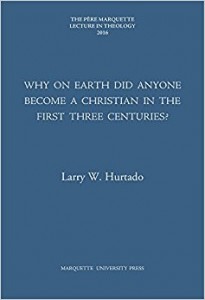 This little hardback contains Larry W. Hurtado’s 2016 Pere Marquette Lecture in Theology. While the text itself is only a little over 120 pages (and the format of the book is small), it is a very insightful and very helpful work that considers the titular question with the skill of a trained and balanced historian.
This little hardback contains Larry W. Hurtado’s 2016 Pere Marquette Lecture in Theology. While the text itself is only a little over 120 pages (and the format of the book is small), it is a very insightful and very helpful work that considers the titular question with the skill of a trained and balanced historian.
Hurtado wants to know why it was that so many people joined the early Christian movement given the immense costs of doing so. He groups these costs under the two general headings of “social costs” and “political/judicial costs” (p.48). He makes the point that limiting a measurement of the cost of joining Christianity only to the number of those actually killed for joining the faith does not offer a true picture, for undoubtedly the greatest costs came through the numerous acts of social pressure and ostracization that would have arisen when Christian particularism clashed with the pervasiveness of the cultural acknowledgement of the Romans god that positively saturated nearly every aspect of Roman life. Hurtado demonstrates this last point well by showing that paying homage to the gods was expected at almost every social, familial, governmental, and cultural event. The primary point of tension, then, was the Christian refusal to offer this homage and the message that such a refusal sent not only to one’s family and social circles but to the state as well. (Hurtado has dealt with this point more thoroughly in his work, Destroyer of the gods.)
Even so, Christianity exploded in terms of growth and this means that there was something in the movement that made these undoubtedly difficult costs worth paying in the minds of the early adherents. Hurtado offers an interesting fly-over of some of the more popular approaches to figuring out just how numerically large Christianity became in the first three centuries. He finally lands on a fairly agnostic position concerning that specific question but does say that by any measure the expansion of Christianity was impressive, “unique” (a word, he notes, that historians do not normally like to use), and, given the costs in question, surprising.
So how do we answer the question? Why, in fact, did anybody on earth become a Christian in the first three centuries? After surveying a couple of proposed answers and finding them lacking, Hurtado suggests that it was, in fact, largely the ideational content of the Christian message itself that made people think that the costs were worth it. In particular, Hurtado points to two Christian beliefs: a loving God and the promise of eternal life.
Concerning the former, Hurtado notes that the concept of a loving God was quite different from the theological conception of the gods held by the Romans. In short, the idea of a God who actually loves people and invites them into relationship with Him represented a stark contrast to the theology of Roman paganism. Concerning the latter, the same can be said. The idea of hope beyond the grave, of eternal life, of life in Heaven with God, was quite different from the widely held Roman conception of death as the end of all things for the individual. Hurtado points to the inscription one can find on Roman tombs that reads, “Non fui, fui, non sum, non curo” (“I was not, I was, I am not, I care not.”) as a fairly accurate indicator of how the Romans viewed death. Against this, Christianity offered the hope of eternal life after the event of death.
Hurtado writes:
There must have been features of early Christian faith that made it not only distinguishable but also worth the consequences often involved in taking it up. Those who joined Christian groups must have perceived some sort of “religious capital” (to use Bremmer’s expression) specific to Christianity that relativized radically the social disincentives of identifying themselves as adherents (p.131).
That is an interesting way of putting it and I think Hurtado is correct. It was the content of the Christian confession as well as the realities that this confession opened up in the lives and experiences of early believers that outweighed “the social disincentives” of becoming a Christian. So it was then. So it is today. The truthfulness of the Christian message must be grasped for the faith to be authentically embraced.
My one quibble with the lecture is the question of whether or not the forgiveness of sins through Christ’s death on the cross specifically should not have been mentioned alongside the love of God and the hope of eternal life. Of course, the forgiveness of sins can rightly be seen as subsisting within both of those broad categories, but one does suspect that the scandal of the message of the cross, particularly in this Roman context, should have been mentioned. For, as the Alexamanos graffito shows, this would have been one of the primary points at which social scorn would have been meted out. There must have been something about the love God revealed through the work of Christ on the cross specifically that made the acceptance of social ostracization on that very same point worth it.
This is a very interesting and very careful little book. Definitely worthy of consideration.
